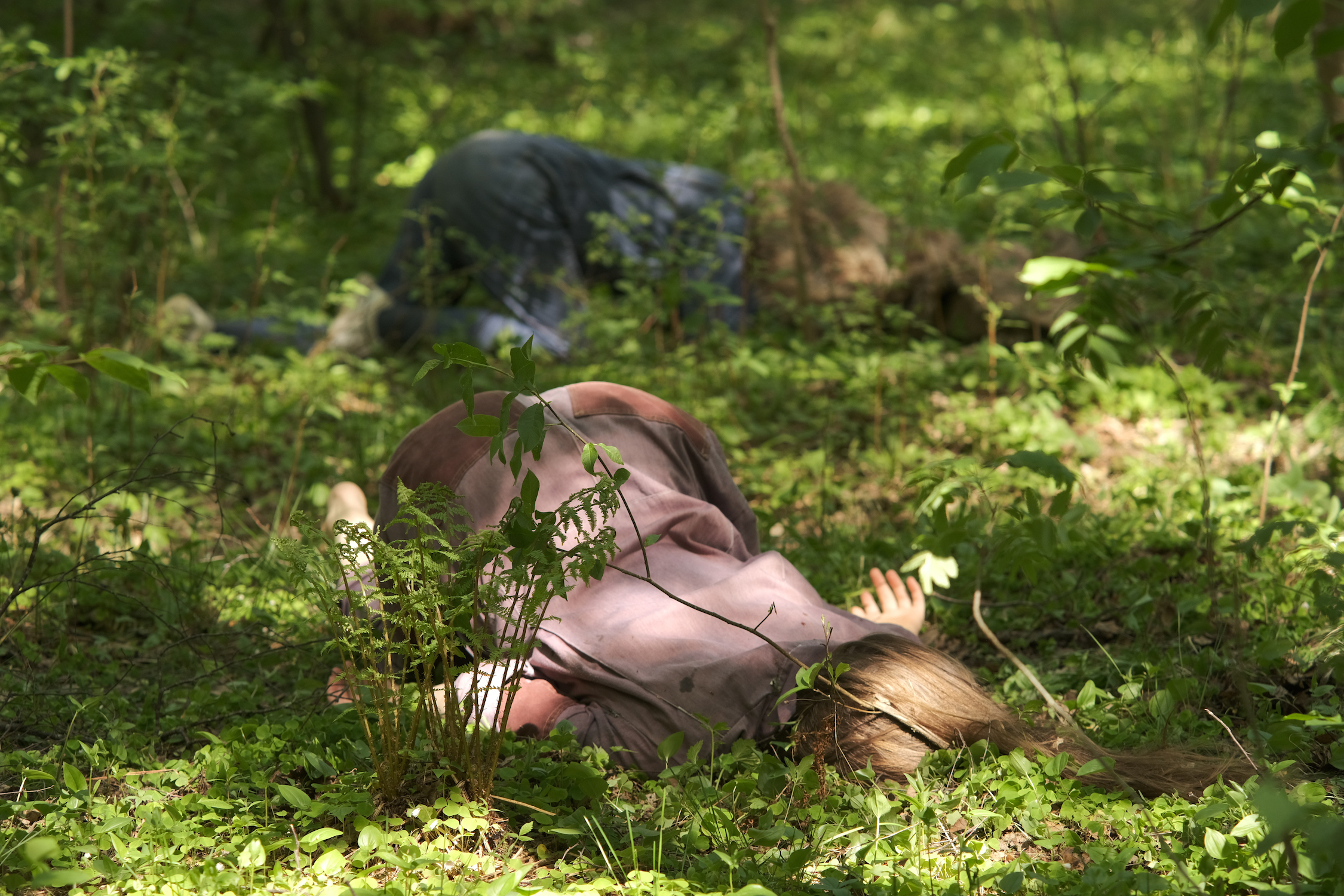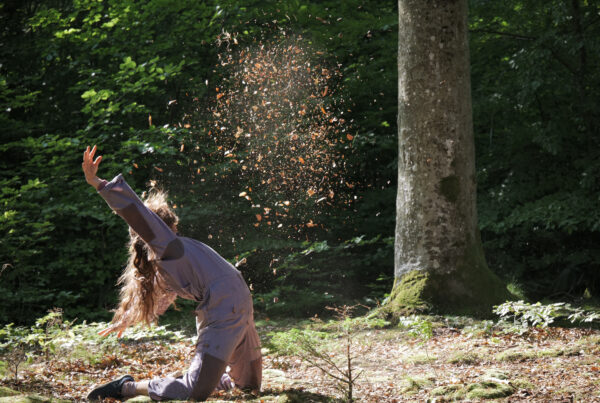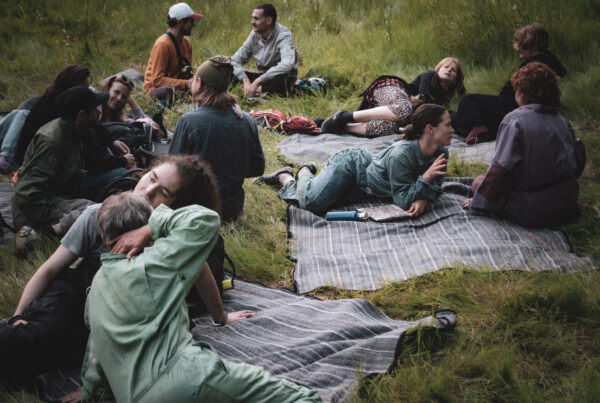Resisting Extinction took a clear ecological stance, while inviting the audience to discover and experience the landscape as a child.
Iirus Viirpalu
BodyCartography Project’s Resisting Extinction, written, directed and performed by Olive Bieringa, directed and performed by Otto Ramstad. Performed by Eline Selgis, Daniel Persson, Helina Karvak, Joanna Kalm, Laura Kvelstein, Nele Suisalu and Uma Ramstad. Premiere 25 May in the Merimetsa conservation area.
Created by the international duo BodyCartography Project (Olive Bieringa and Otto Ramstad) and performed in May in Merimetsa and on Stroomi beach by Estonian and foreign dancers, the site-specific production “Resisting Extinction” takes a clear ecological stance, while inviting the audience to discover and experience the landscape as children. As a work that is more of a hike or a walk than a stage play, it engaged the audience directly with their surroundings, encouraging them to discover and notice the wonders of nature, providing an impactful and thought-provoking experience of environmental crises.
The team of Resisting Extinction acted more like dancing guides than performers, and blended naturally into the environment.
Immersing myself in the environment as a wanderer with eyes wide open, with empathy and respect for nature’s very being, instead of passively watching, brought back memories of childhood, when I used to visit and explore nature with the same full presence and attention. This time, the experience seemed to be matched by how close the audience allowed themselves to become to what was happening, and how deep into the tissues of the journey they were able to enter and relax. The makers of the production have created a fitting structure to get a sense of the birdsong, the crackling sounds, the texture of the moss, the scent of the flowers of the plants, through imagination and observing the surroundings. There is presence: there is only the present, the real, tangible, multidimensional world, where there is no place for screens and mediation. In the midst of the thicket and along paths trodden in moss, the performer runs as if following a pan straight into a summer night’s slumber.
This production’s awareness of the environment and the ecological crisis takes on a rather experimental form in Estonian dance scene, which distinguishes it from most of the works that have come out in recent years. This time, site-specificity is not merely in the service of decoration or showmanship: the site amplifies the theme, and the production is resonant of people’s direct experience of nature, albeit directed by the performers. The whole action is engaging and practical rather than distantly demonstrative.
The production is memorable for its intimate tonality and its personality. The intimacy manifests itself in the relationship between the performer and the audience, in the way the audience is sensitively and respectfully guided to relate and interact with the landscape, species and nature of Merimetsa. On the other hand, it is the intimacy of the experience of nature, where the audience is guided to experience nature in an active but very personal way.
For example, I was asked by a performer to leave a message on a tree in Stroomi beach, we had taken a seat and felt its form with our bodies. The personal nature of the message – I leave my own message, however emotional or private, on the tree – pointed to my proximity to other species and organisms, underlining also the place of the human being within and at the center of the ecosystem. The performer suggested either drawing the message invisibly with a finger on the trunk or whispering it to the tree.
The performance gave the impression of empathy and respect for both the audience (although it would be more accurate to say ‘fellow human beings’, given the intention and nature of the production) and the whole species community and landscape that shaped the mood and the stage. In this way, the production is in line with the Norwegian philosopher Arne Naess’ concept of deep ecology1, according to which all organisms and species found in nature are self-valuable and the relationship between species and organisms is inseparable. This concept underpins an ethics-based view of nature that sees everything in nature as subjects, not objects.
I liked the fact that the topic was approached primarily from a perceptual rather than an academic and conceptual point of view. Man exists in the world and in nature primarily as a physical being. In our everyday lives we are sometimes detached from the rest of the species, accustomed to and numbed by the conditions of the artificial environment, but our profound essence is total physicality. We are purely (!) organic, just like the other species, and ultimately composed of the same chemical elements. The production emphasizes the inextricable link between the human being and the environment, and heightens a dormant sense of perception precisely through the sensation of nature and the positioning of the body in space.
The production thus became a rather tactile and sonic olfactory journey. All of nature is, in fact, a work of art to be admired and respected. This seemed to be the point of the production, which was also expressed in the staging techniques and the particular time space, precisely because of the amplification of perception. Curating their own microcosm, a place brimming with discovery, seemed to be the main contribution of the performers: they acted more like dancing guides than performers, and also blended naturally into the environment. The shadows of the tree leaves, the sun patterns on the forest paths and the crows were there independently of the performers and took the lead role on several occasions.
The most conceptual and choreographed part was the final section, which, inspired by ecological thought, described in detail the chemical-physical processes that take place in the body during clinical death and organic decomposition. Death, decomposition and decay are the most natural things in nature, yet death and aging are feared by all humanity. This is probably one of the reasons why the and consequences of the ecological catastrophe are not yet fully understood. Who would want to imagine dying because of drought and lack of water? Or freezing to death because of an extreme climate? The precise description created an interesting and necessary distance: it was precisely because of the detail that it was possible to imagine the decomposition of one’s body as a natural inevitability rather than a personal, human tragedy.
After all, the survival of nature after the disappearance of man as a species might even be a somewhat Zen-like reassurance in these times, in order to cope with ecological anxiety and depressing news. Nature is bigger and older than man.



